Leaf Embroidery
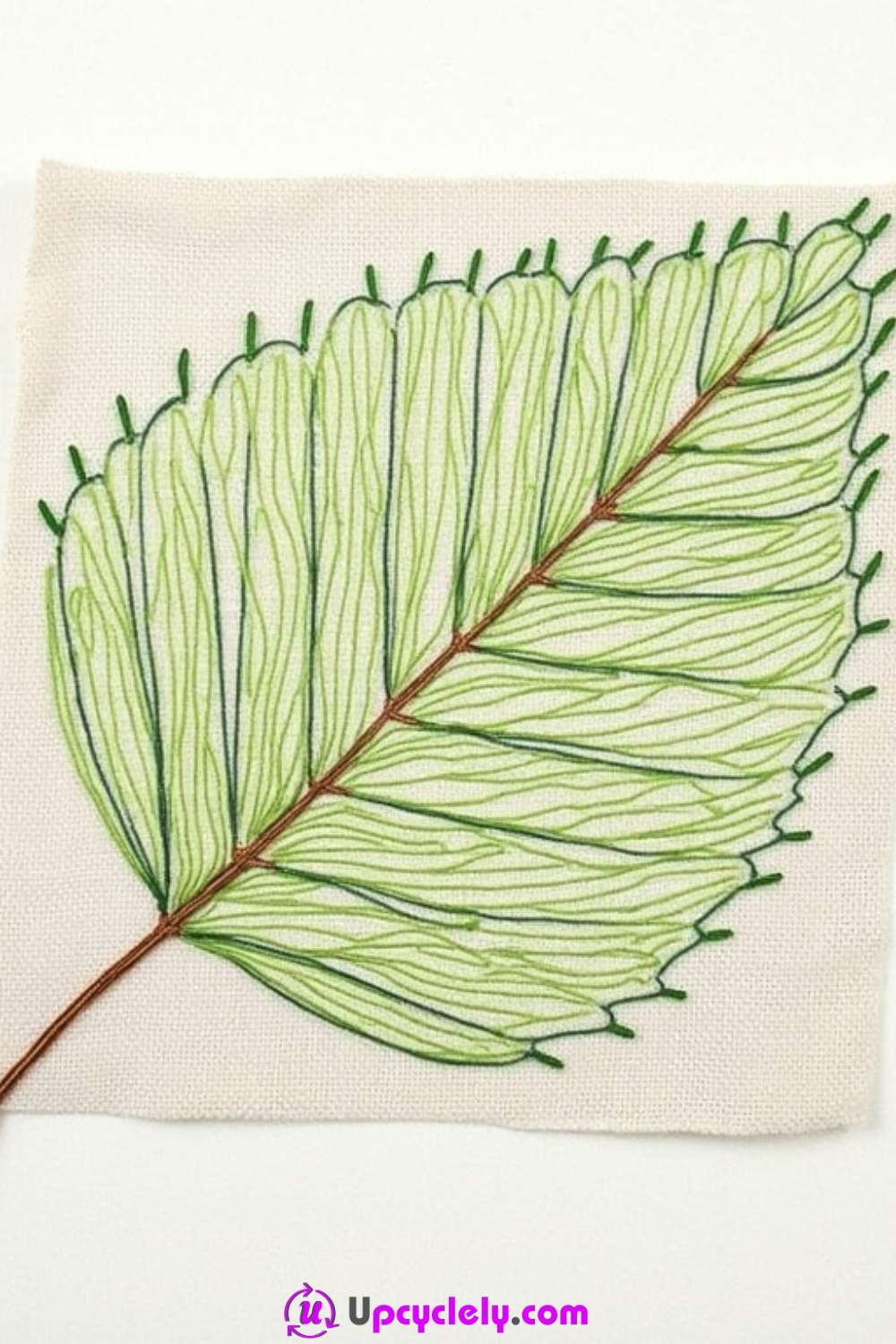
Materials Needed:
- A plain square piece of fabric (light beige or white works best)
- Embroidery hoop
- Embroidery threads in shades of green and brown
- Embroidery needle
- Scissors
- Pencil (for outlining)
Steps:
- Outline Your Leaf Design
I like to start by softly sketching the shape of the leaf onto my fabric using a pencil. It doesn’t have to be perfect, but this outline will help guide the embroidery. You can use a real leaf as inspiration for its veins and overall shape. - Secure the Fabric
Place your fabric inside an embroidery hoop and pull it taut. This step is key in keeping your stitches even and clean. Every time I secure the fabric, it feels like an empty canvas ready for art. - Begin Embroidering the Stem
Thread a brown embroidery thread through your needle. Start with the stem by using a simple backstitch in a diagonal direction. Watching the thread slowly come to life as a stem is always my favorite part. - Add Leaf Details
Choose two or three shades of green. Start with a darker shade to outline the edges of the leaf. Then, use lighter colors to fill in the veins. Stitching layer by layer can seem tedious, but trust me, the final look is worth every minute.
Pro Tip:
To create a more realistic texture, use a satin stitch for the veins and combine it with a long-short stitch for the leaf’s body.
Leaf and Twig Frame
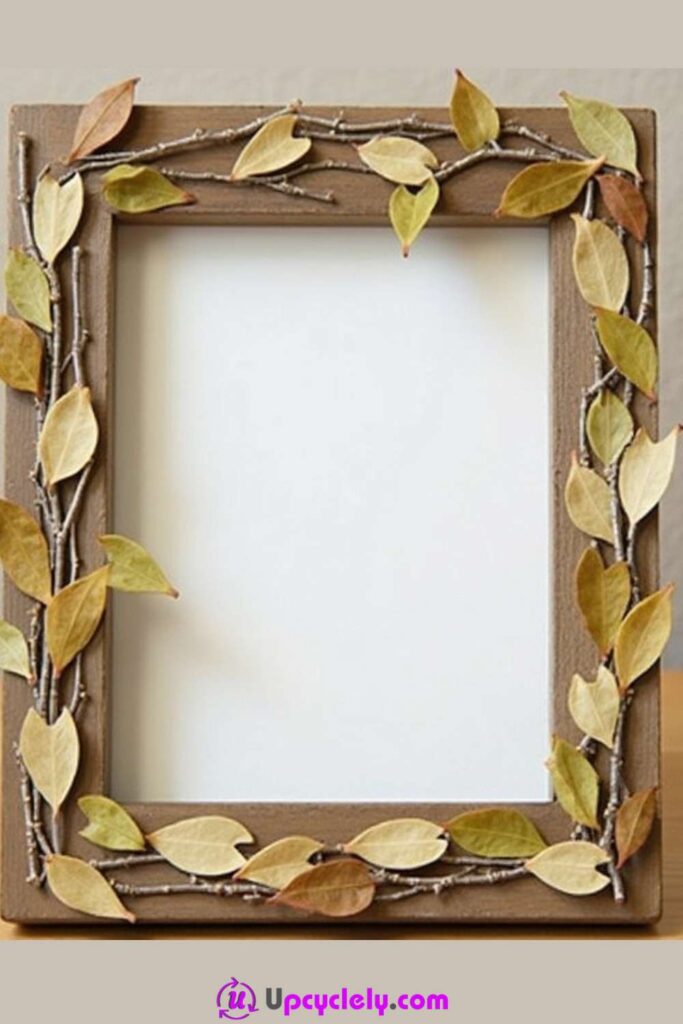
Materials Needed:
- A plain rectangular picture frame
- Dried twigs and leaves (I recommend autumn colors like green, yellow, and orange)
- Hot glue gun and glue sticks
- Scissors
- Clear varnish (optional for a polished finish)
Steps:
- Collect and Prepare Materials
I like taking a calm walk and collecting twigs and leaves for this project. Select pieces that are intact and sturdy. Trim the twigs and leaves as needed to ensure they’ll fit along the edges of your frame. - Plan the Arrangement
Once at home, lay your twigs along the edges of the frame and mix in leaves to create a balanced design. It might take a little patience to get the perfect layout, but remember, nature isn’t symmetrical, so imperfections are part of the charm. - Glue Everything in Place
Heat your glue gun and carefully attach each twig to the edges of the frame. Work your way around the sides, layering in the leaves as you go. Watching the frame transform into something beautiful is so rewarding. - Seal and Set
If you want your frame to last longer, lightly brush the entire surface with clear varnish. Be gentle so the leaves don’t lose their natural look or texture.
Pro Tip:
Add tiny flowers or seeds for an extra rustic vibe that pops!
Leaf Bookmarks
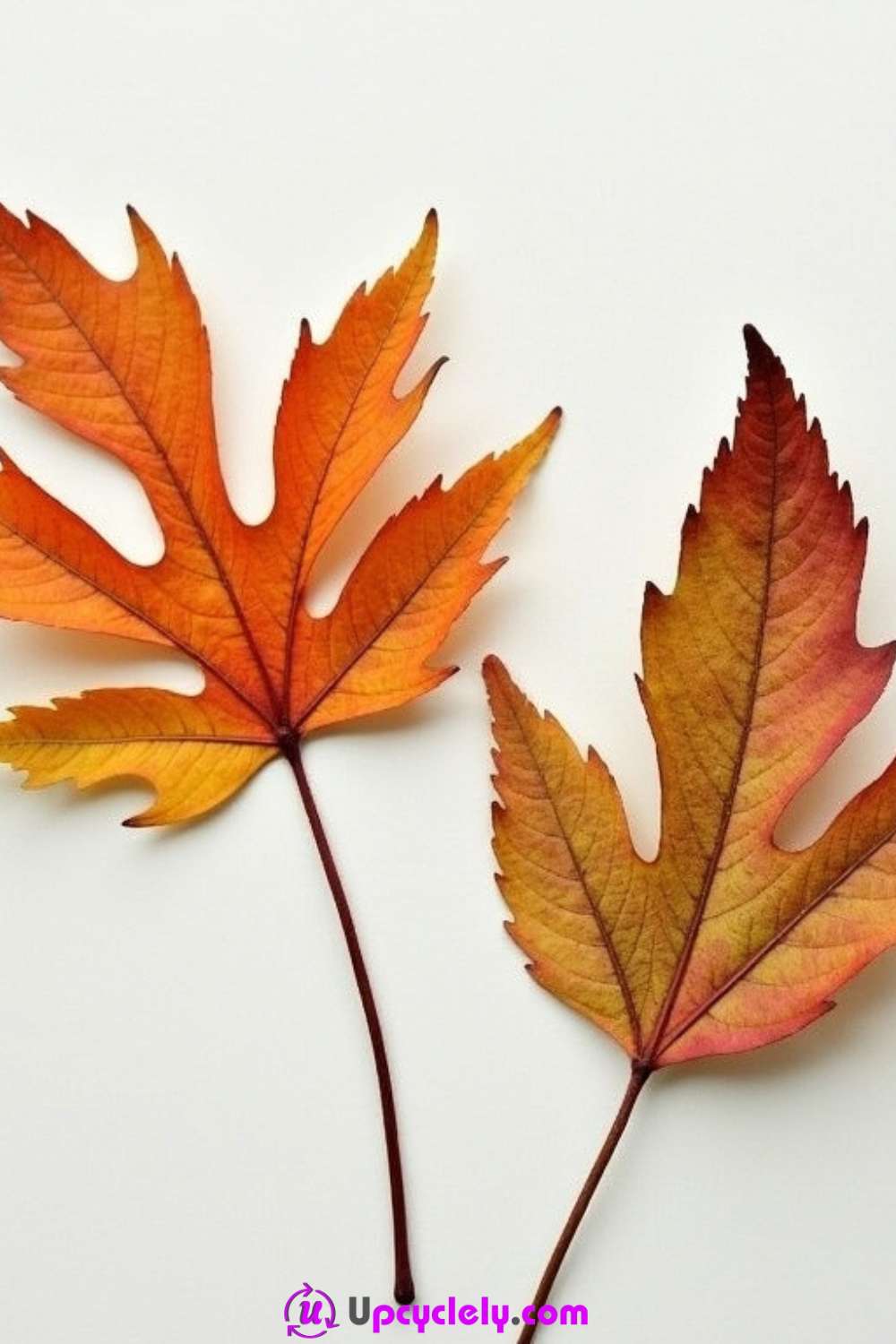
Materials Needed:
- Two vibrant autumn maple leaves (real or artificial)
- Laminating sheets or clear contact paper
- Scissors
- Hole punch
- Ribbon or twine
Steps:
- Choose the Perfect Leaves
Selecting leaves is probably the most fun. Look for ones with beautiful color gradients and visible veins. If you’re using real leaves, gently clean them with a soft cloth before starting. - Laminate the Leaves
Place each leaf inside a laminating sheet or sandwich it between two pieces of clear contact paper. Smooth out any bubbles with your hand. I love how this step instantly enhances the leaves’ colors! - Cut and Shape
Once laminated, cut neatly around the leaf, leaving a small border to keep it sealed. You can also trim the edges into a fun shape if you like, though I prefer to keep the natural outline. - Add a Ribbon or Twine
Punch a hole near the stem and loop a ribbon or piece of twine through it. This adds a little flair to your bookmark and makes it easy to spot in a book.
Pro Tip: Press your real leaves between heavy books for two days before laminating to keep them flat.
Leaf Coasters
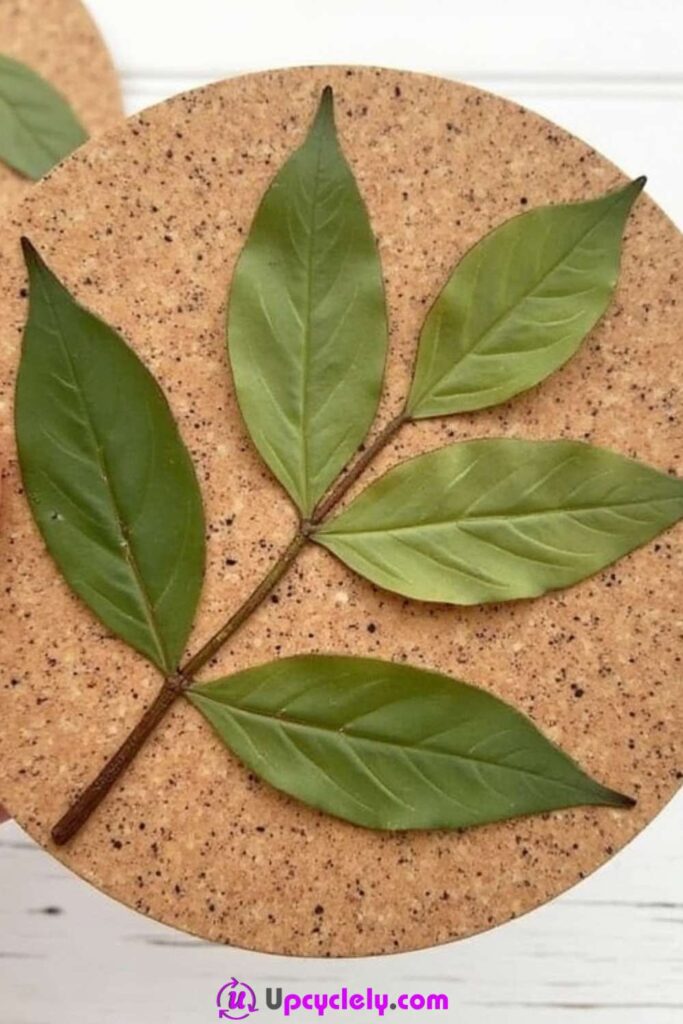
Materials Needed:
- Circular cork coasters
- Real green leaves (fresh or faux)
- Mod podge
- Small paintbrush
- Scissors
Steps:
- Prepare the Coaster Base
Take a cork coaster and make sure it’s clean and smooth. Wiping it down with a damp cloth helps remove any dust or debris. - Arrange the Leaves
Lay your green leaves on top of the coaster. Experiment with placement to find the look you like best. I love achieving a flowy, natural aesthetic by overlapping the leaves. - Adhere the Leaves
Apply a thin layer of mod podge to the coaster. Press the leaves gently onto the surface and make sure they’re flat with no air bubbles underneath. - Seal the Coaster
Brush another layer of mod podge over the leaves and entire coaster surface. Allow it to dry fully before using it. This step gives the coaster a glossy, polished finish that’s also protective.
Pro Tip:
Seal with waterproof mod podge if you plan to use these coasters for drinks.
Leaf Collage Art
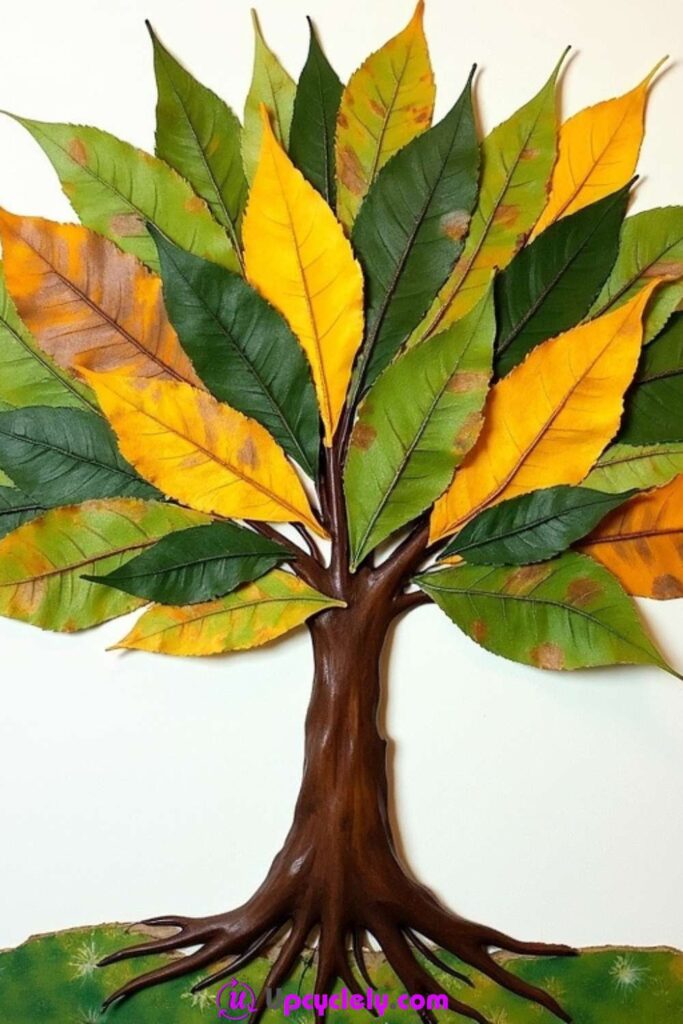
Materials Needed:
- A sturdy sheet of canvas or cardboard
- Dried leaves in various colors (green, yellow, orange, and brown)
- Glue
- Paint for extra detailing (optional)
- Small paintbrush
Steps:
- Sketch the Tree Design
Draw the outline of a tree on the canvas. Picture a thick trunk with wide-spreading branches. This serves as your foundation. Every time I imagine the final piece, it motivates me to get started. - Glue on the Leaves
Begin gluing leaves along the branches to form the canopy. Mix colors to show the changing seasons. Watching the transformation as each leaf adds texture is so satisfying. - Layer for Depth
Overlap leaves to create a dense and full look. You can even curl some of the leaves slightly for natural dimension. It starts to resemble a real tree as you layer. - Add Finishing Touches
If you want, use a brush to paint small accents like tiny flowers or highlights on the branches. It’s a simple way to elevate your art while keeping the focus on the leaves.
Pro Tip:
Use glossy-finish glue to make the leaves appear vibrant. Spray with a fixative to keep them preserved.
Leaf Garland
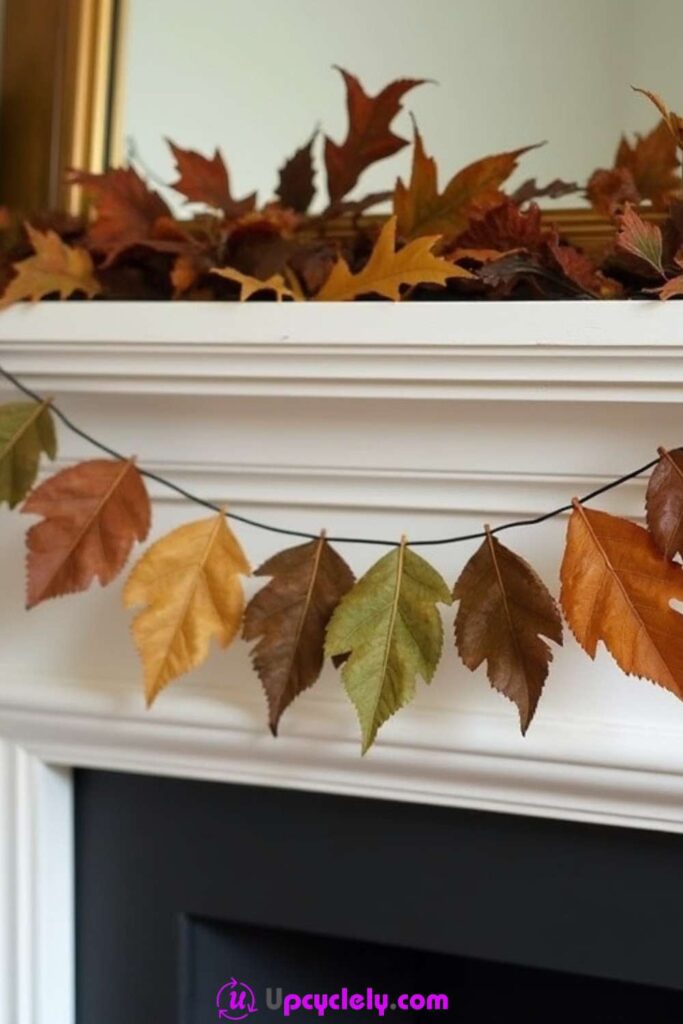
Materials Needed:
- Dried or artificial leaves in autumn colors (brown, yellow, orange, green)
- Jute string or thin wire
- Hot glue gun and glue sticks
- Scissors
- Optional: tiny clothespins or decorative beads
Steps:
- Gather and Prepare Your Leaves
I love starting by picking out leaves in a range of warm, autumnal shades. Real leaves can be carefully dried and flattened in a heavy book for a few days, while artificial ones are ready to use straight away. Make sure the leaves are clean and flat for an even look. - Cut the String to Length
Lay out the jute string or wire along the mantel or space where you’ll hang the garland. Add about an extra foot to the total length so you have room to tie knots or hooks for hanging. This part always makes the project feel more real, as I start seeing how it will look in the space. - Attach Leaves to the String
Decide the arrangement of your leaves. For a rustic touch, alternate the colors and overlap them slightly. Use a hot glue gun to carefully adhere each leaf to the string or wire. Make sure they’re spaced evenly, about 2–3 inches apart. Watching the garland take shape is such a joy for me! - Add Extra Details (Optional)
To elevate your garland, clip on tiny clothespins, beads, or even acorns. These tiny touches create a charming, handcrafted look. I find this step adds a personal touch and makes the garland uniquely mine.
Pro Tip:
If you’re using real leaves, spray them with a clear varnish to preserve their color and prevent crumbling over time.
Leaf Greeting Cards
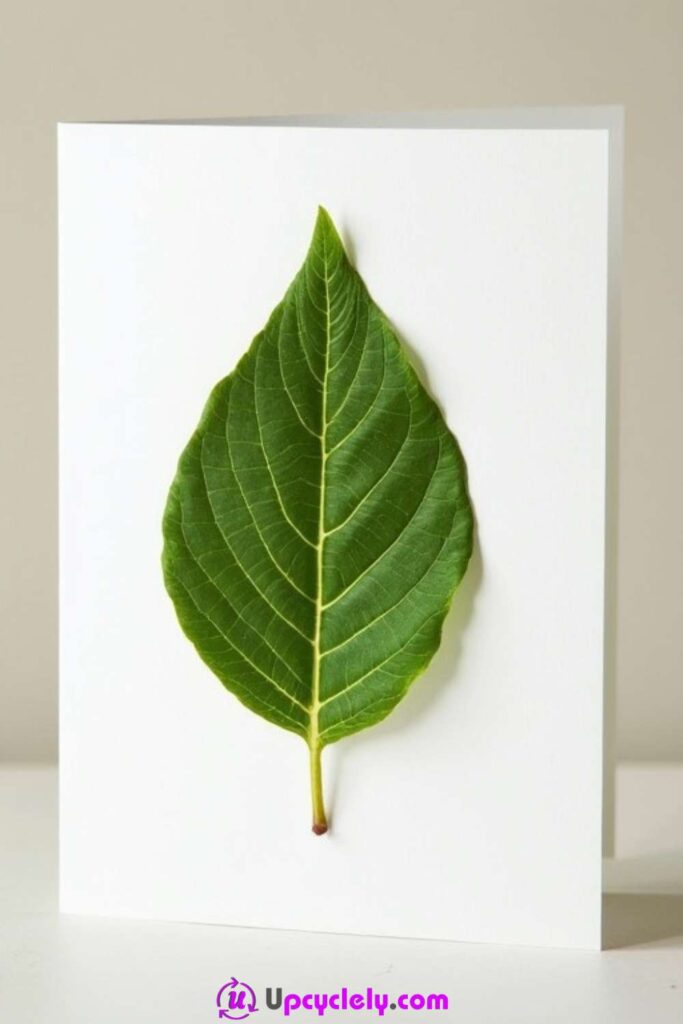
Materials Needed:
- Blank greeting cards (white or cream)
- Real or artificial leaves (one per card)
- Glue stick or glue dots
- Fine-tip markers or metallic pens
- Pressing book (if using real leaves)
Steps:
- Choose the Perfect Leaf
Every great card starts with a beautiful leaf. Find one with clear veins and a pleasing shape. For real leaves, flatten them in a book for a few days to make them easier to work with. I always feel like nature is gifting me little treasures when I find the perfect one. - Design Your Layout
Place the leaf on your card to decide where it fits best. You can position it vertically down the center or slightly tilted for a more natural appearance. I like studying how the leaf interacts with the blank space before gluing it down. - Adhere the Leaf
Apply a thin line of glue or a glue dot to the back of the leaf, focusing on the stem and larger veins. Press it gently onto the card and smooth it out, starting from the center. Seeing the card come to life always brings a sense of accomplishment. - Add a Sentimental Touch
Use your markers or pens to write a message around or beneath the leaf. It could be a simple “Thank You” or even a nature-inspired quote. Adding this personal element makes it more meaningful to the recipient.
Pro Tip:
Metallic pens, especially gold or copper, contrast beautifully with rich green and autumnal leaf tones.
Leaf Handprint Craft
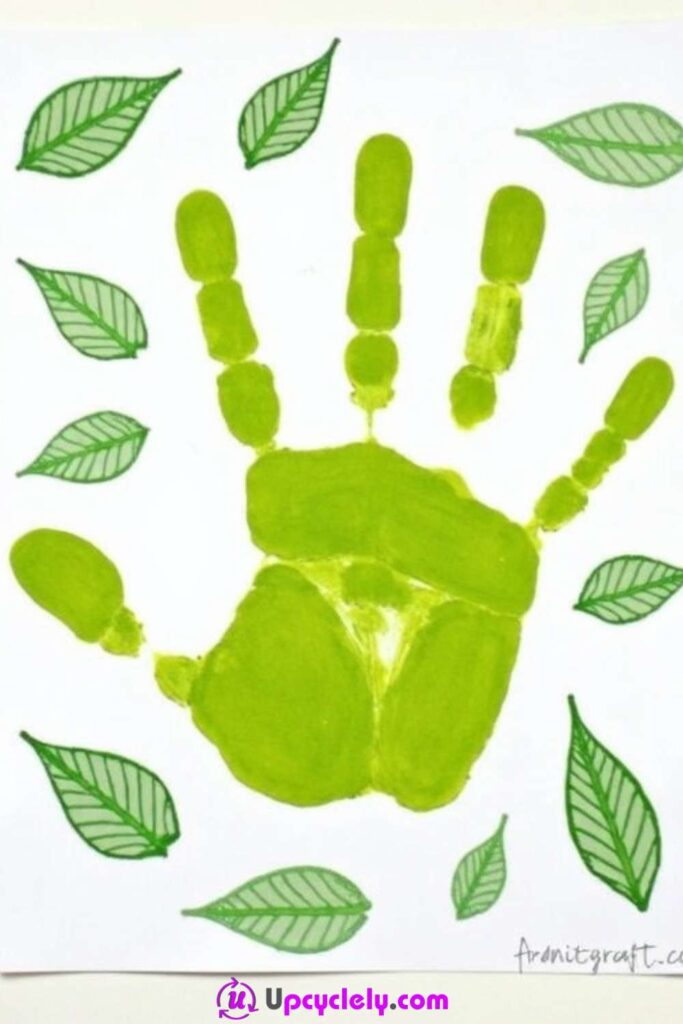
Materials Needed:
- Thick white cardstock
- Green paint
- Paintbrush
- Fresh green leaves (various sizes)
- Baby wipes (to clean hands easily)
Steps:
- Prep Your Supplies
Spread out your cardstock and paint supplies. I like to wear an apron or use an old tablecloth to keep things mess-free. Having baby wipes nearby is also super helpful! - Create the Handprint Base
Apply green paint evenly to your hand using a brush. Press your painted hand gently onto the cardstock to create a vivid handprint. Seeing my handprint come alive on the page always reminds me how unique each person’s mark is. - Decorate with Leaves
While the paint dries, arrange some leaves around the handprint to complement its shape. Use elongated leaves to mimic fingers or rounder leaves to frame the print. This step really turns the handprint into a vibrant display of creativity. - Glue the Leaves in Place
Secure each leaf with glue, flattening them against the cardstock. Once everything is dry, your handprint craft will burst with personality and a beautiful nature-inspired theme.
Pro Tip:
Turn this into a keepsake by writing the date or name below the print. It’s perfect for family activities or kids!
Leaf Lanterns
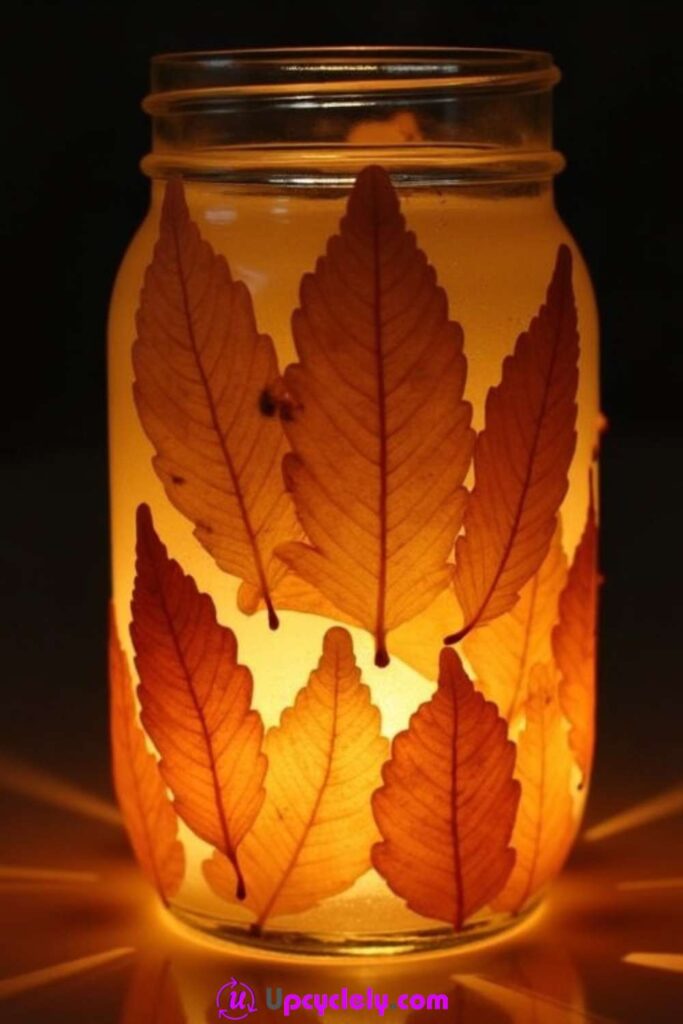
Materials Needed:
- Glass jars (mason jars work great)
- Pressed autumn leaves
- Mod podge
- Paintbrush
- Tea light candles or battery-operated lights
Steps:
- Prepare the Leaves and Jars
If you’re using real leaves, press them until they’re nice and flat. Wash and dry the jars thoroughly. I always feel a little thrill imagining the transformation of plain jars into glowing art pieces. - Apply Mod Podge to the Jar
Use a paintbrush to coat a section of the jar with mod podge. Work in small areas to avoid it drying too fast. - Add the Leaves
Press a leaf gently onto the glued area, smoothing it down with your fingers. Continue this process, overlapping leaves slightly for a layered composition. Watching the colors and textures of the leaves blend together is so satisfying. - Seal the Design
Once the leaves are all in place, apply another thin layer of mod podge over them to seal and protect. Allow it to dry completely before adding a lit candle or battery light inside. The warm glow through the leaves feels so magical every time.
Pro Tip:
For added coziness, tie a piece of twine or ribbon around the rim of the jar to complete the look.
Leaf Magnets
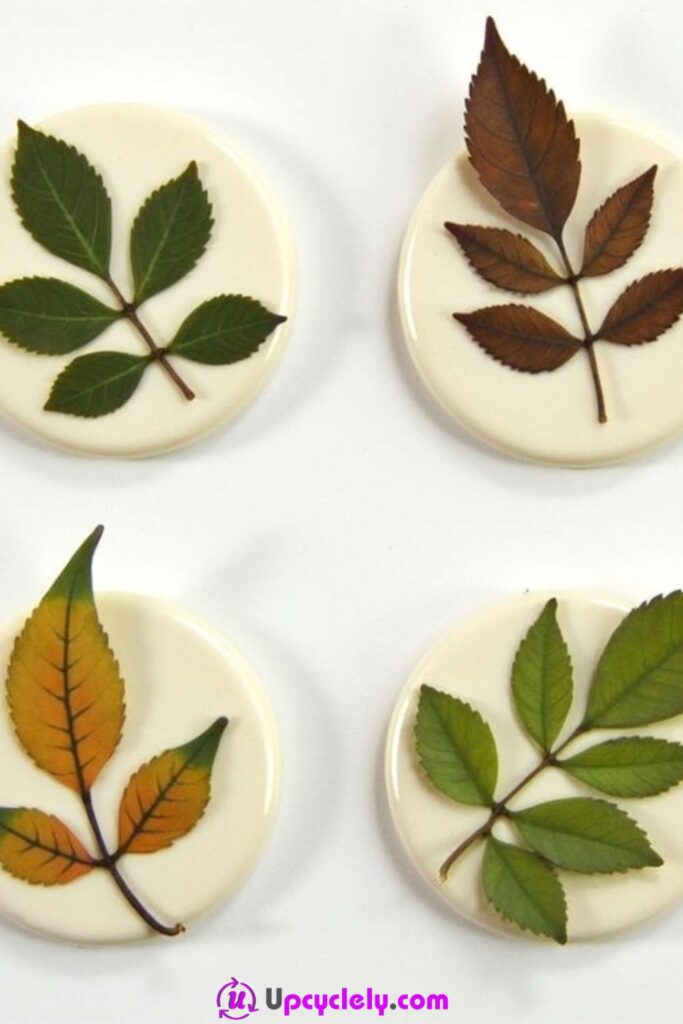
Materials Needed:
- Small circular wood slices or cork bases
- Dried leaves (small varieties work best)
- Clear-drying glue
- Craft magnets
- Mod podge or clear sealant
Steps:
- Prep the Base
Sand the wood or cork pieces lightly for a smooth surface. This little detail always makes a big difference in the final finish. - Select and Attach Leaves
Pick small, delicate leaves and test their placement on the base. Once you’re happy with the layout, glue each leaf onto its base. It’s exciting to see how each magnet will have its own unique look. - Coat and Protect
After the glue dries, brush on a layer of mod podge or sealant to secure the leaves. This step is a bit tedious but totally worth it to ensure the magnets are durable. - Attach the Magnets
Glue a strong craft magnet to the back of each base. Give it enough time to dry so it holds firmly. I always love this stage because the magnets are now ready to decorate my fridge or gift to loved ones.
Pro Tip:
Match the leaf and background color combinations to your home decor or seasonal themes.
Leaf Stamps
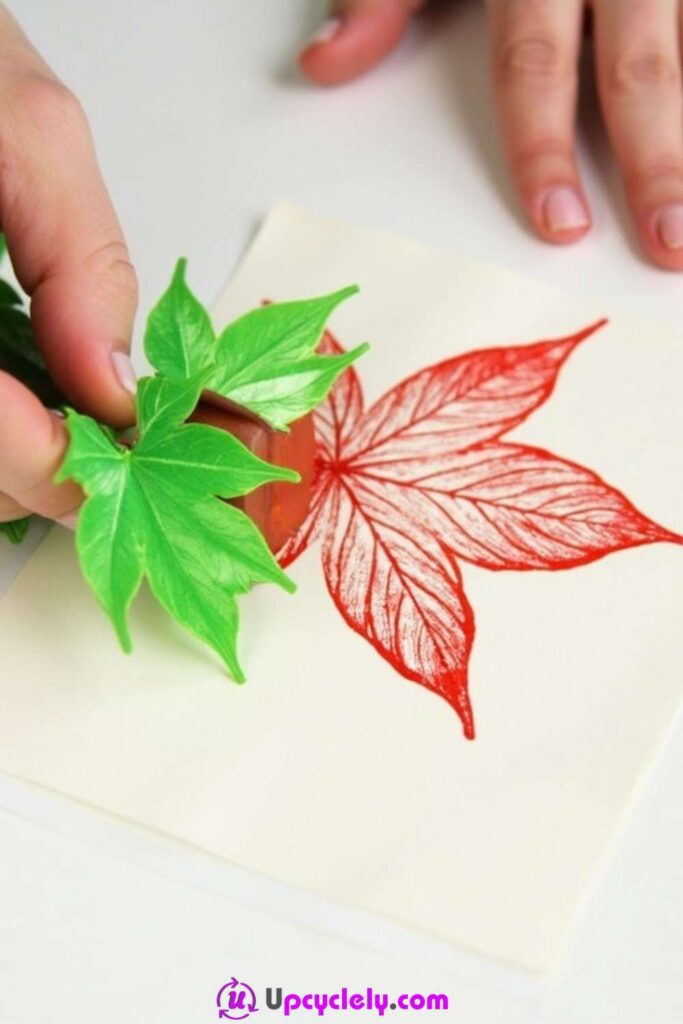
Materials Needed:
- Fresh green leaves with clear vein patterns
- Acrylic paint in assorted colors
- Paintbrush
- White cardstock or blank paper
- Small plate or tray for paint
Steps:
- Choose the Perfect Leaves
I like to pick leaves with distinct shapes, like maple or fern leaves. The veins and edges need to be well-defined, as they’ll create the design. Make sure the leaves are clean and dry, ready for stamping. - Prepare Your Paint Palette
Squeeze small amounts of acrylic paint onto a plate and mix in some water to thin it out slightly. This makes the paint easier to work with. One of my favorite parts is choosing colors that pop, like red, orange, or gold, to bring out the details. - Paint and Press
Use a brush to coat the underside of a leaf with a thin, even layer of paint. Then press the painted side firmly onto your paper. Hold it down for a few seconds before lifting it gently. The magic moment comes when you see the leaf’s print and all its intricate veins! - Repeat and Create Patterns
Experiment with different leaves and colors to create a repeating pattern or a unique composition. Watching the page fill with lively prints always fills me with excitement.
Pro Tip:
Use metallic paint for an extra-special touch. It adds shimmer and makes your prints look elegant and festive.
Leaf Notebooks
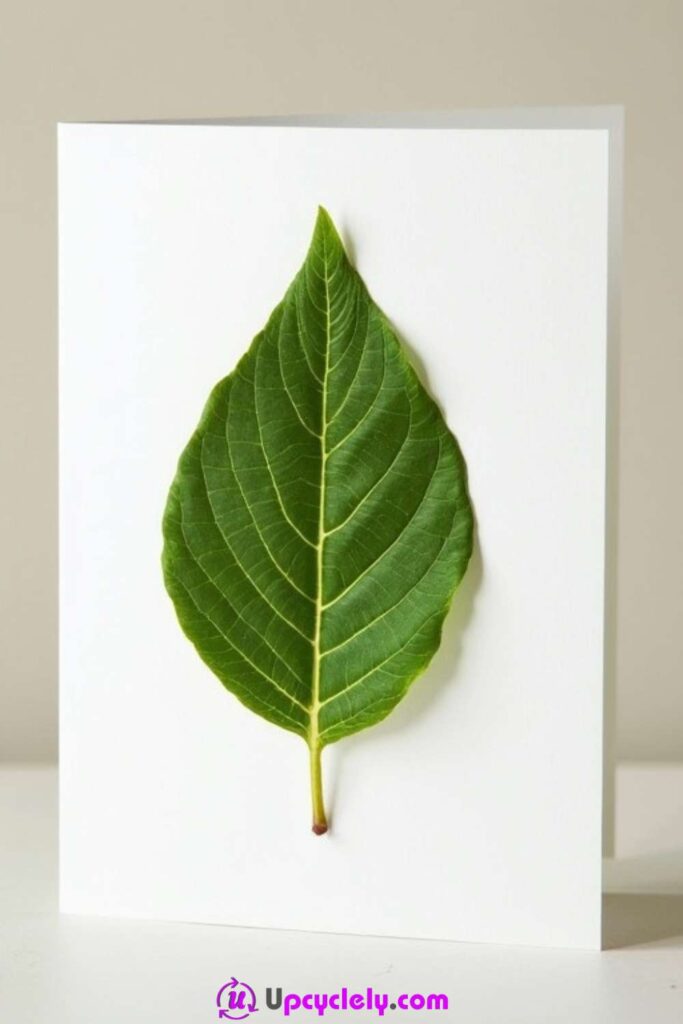
Materials Needed:
- Blank notebooks (hardcover or spiral-bound)
- Dried leaves (real or artificial)
- Clear self-adhesive vinyl or contact paper
- Glue
- Scissors
Steps:
- Collect and Press Your Leaves
For this project, I love using real leaves. Press them between the pages of a thick book for about a week to make them completely flat. If you’re short on time, artificial leaves also work wonderfully. - Arrange Your Design
Lay out the leaves on the notebook cover to find a beautiful arrangement. I like mixing shapes and sizes, overlapping some to create depth. - Secure the Leaves onto the Cover
Use a touch of glue to attach the leaves to the notebook cover. Don’t worry if it’s not perfect; the next step will seal everything in place. Seeing the leaves turn the plain cover into a lively, nature-inspired piece is so rewarding. - Cover with Vinyl or Contact Paper
Carefully cut the self-adhesive vinyl to size and stick it in place over the cover. Smooth out any bubbles. This not only holds the leaves in place but also protects them, ensuring your notebook lasts.
Pro Tip:
Add a small label or tag in the corner for personalizing the notebook, perfect for gifting.
Leaf Painted Rocks
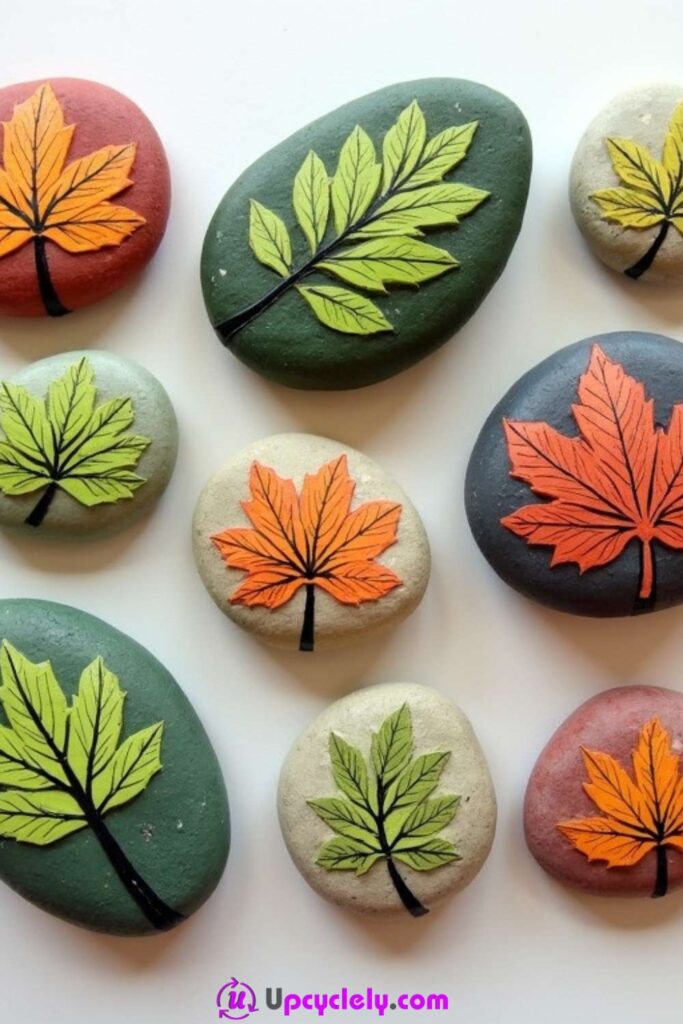
Materials Needed:
- Smooth stones (river rocks work best)
- Acrylic paints in vibrant colors
- Paintbrushes (fine-tip for details)
- Clear varnish or sealant
Steps:
- Prepare the Rocks
Clean each rock with soap and water, then dry them completely. For me, prepping these blank canvases always sparks ideas for the final designs. - Base Coat
If you’d like a colorful background, paint a base coat on the stone and allow it to dry fully. White, beige, or pastel colors make a great background for showing off vibrant leaf designs. - Paint Your Leaf Design
Use fine-tip brushes to paint the outline of a leaf directly onto the stone. Fill in the leaf with your chosen colors, layering if needed for brightness. I find painting the veins and details so meditative; it’s where the design comes to life. - Seal the Rocks
Once the design is fully dry, apply a coat of clear varnish to give the rocks a polished, shiny finish. They now look like little treasures, perfect for garden decor or as unique gifts.
Pro Tip:
Test different leaf styles! Maple for autumn vibes or palm leaves for a tropical touch.
Leaf Pressing
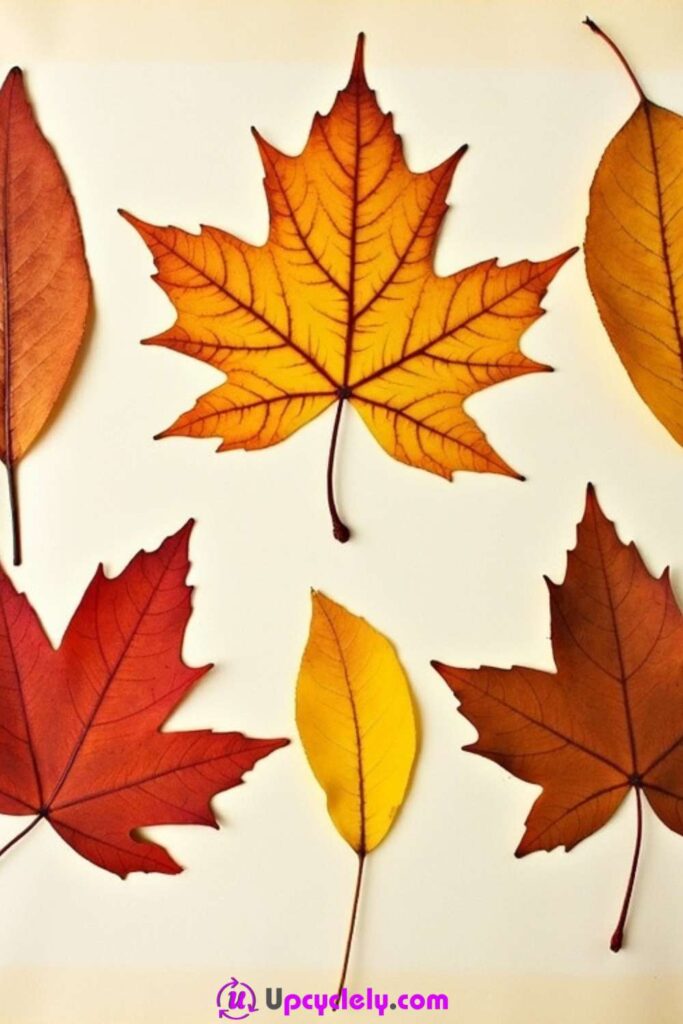
Materials Needed:
- Fresh autumn leaves in various colors
- Heavy books or a leaf press
- Wax paper or parchment paper
- Tweezers
Steps:
- Select Your Leaves
Go for a walk and gather vibrant, colorful leaves. Choosing fresh ones ensures they don’t crumble. I always feel grateful during this step, enjoying nature while collecting materials. - Flatten the Leaves
Place each leaf between two sheets of wax paper and arrange them without overlap. Sandwich the wax paper in the center of a heavy book or in a leaf press. Layers make it easier to handle multiple leaves at once. - Press for Days
Leave the leaves in the press for at least 5–7 days. The anticipation of checking the dried, flattened leaves always gets me excited. - Reveal and Use
Carefully peel the leaves from the wax paper. They’ll be flat and preserved, ready for art projects or decor. I love framing them for display!
Pro Tip:
Spray pressed leaves with clear varnish to make them last even longer without fading.
Leaf Stained Glass
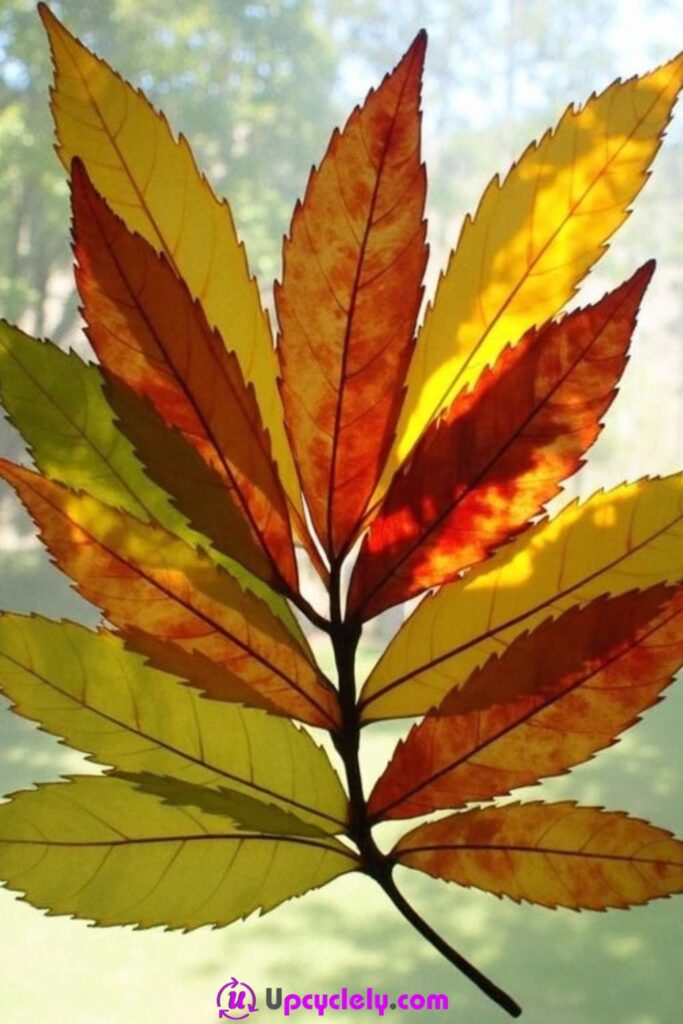
Materials Needed:
- Colored tissue paper in autumn hues (red, orange, green, yellow)
- Black construction paper
- Clear contact paper
- Scissors
Steps:
- Create the Base Design
Draw and cut a large leaf shape from black construction paper, leaving the outline intact (sort of like a frame). This step is crucial for creating that stained glass effect. - Cut Tissue Paper
Tear or cut your tissue paper into small, irregular shapes. I love mixing colors to create an autumn palette that feels warm and vibrant. - Fill the Leaf Frame
Lay the black frame onto the sticky side of the contact paper. Begin layering the tissue paper pieces inside the frame, overlapping slightly to blend the colors. Watching the design form always feels so magical! - Seal Everything Together
Cover the top with another layer of contact paper to seal it in. Trim any excess around the edges, and your stained glass leaf is ready to display on a sunny window.
Pro Tip:
Hang multiple pieces together as a collection for a stunning seasonal window display.
Leaf Wall Art
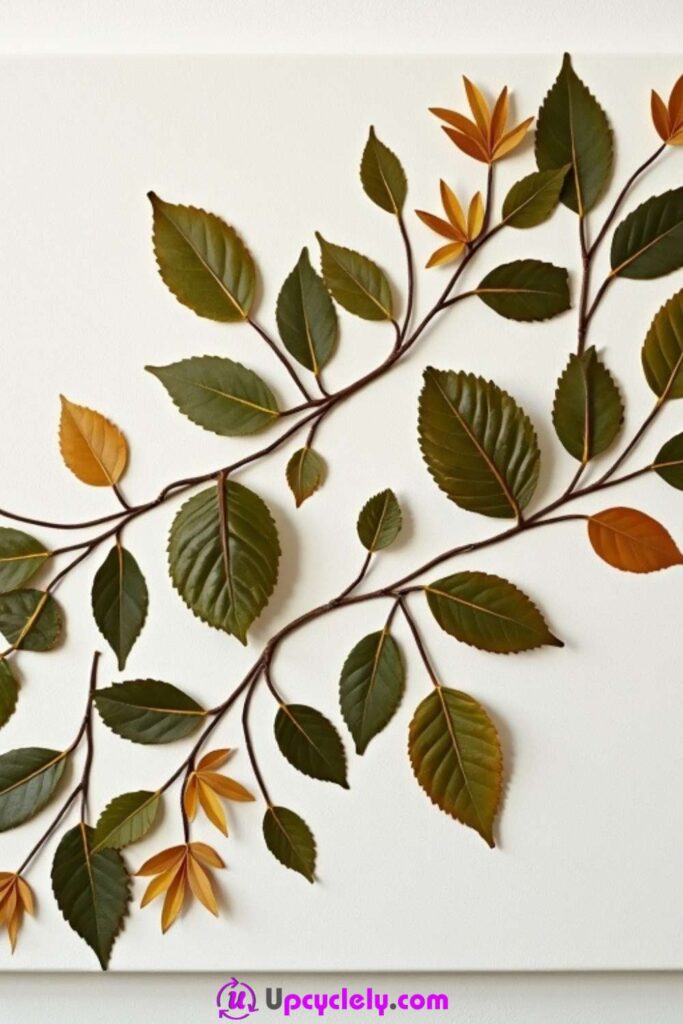
Materials Needed:
- A white canvas or thick cardboard
- Real or artificial leaves in autumn colors (greens, yellows, oranges, and browns)
- Small, thin branches or twigs
- Hot glue gun and glue sticks
- Scissors
- Clear varnish spray (optional for protection)
Steps:
- Gather and Sort Your Leaves
Take a nature walk and gather a variety of leaves in different colors and sizes. Choose pairs of larger vibrant leaves and smaller ones to create balance in your design. For me, this step is therapeutic. I love spending time outdoors, noticing the beauty of every fallen leaf. - Plan Your Design
Spread your leaves and twigs out onto the canvas without gluing them yet. Start by arranging the twigs diagonally to mimic natural branches, then attach leaves along these branches. I enjoy moving pieces around until the arrangement feels just right. Don’t feel rushed; this kind of project rewards thoughtfulness. - Attach the Twigs and Leaves
Use a hot glue gun to secure the twigs first, as they provide the base structure. Next, glue the larger leaves along the twigs, followed by smaller leaves to fill in gaps and add dimension. Watching the design come alive with color fills me with so much pride. - Seal and Preserve Your Work
Once everything is glued in place and dry, lightly spray with a clear varnish to protect the leaves and create a finished look. This optional step helps preserve the colors and gives your art a subtle sheen.
Pro Tip:
Use pressed leaves for a flatter appearance if you’re going for a more minimalist look. Frame your leaf wall art to make it even more of a statement piece!
Leaf Sun Catcher
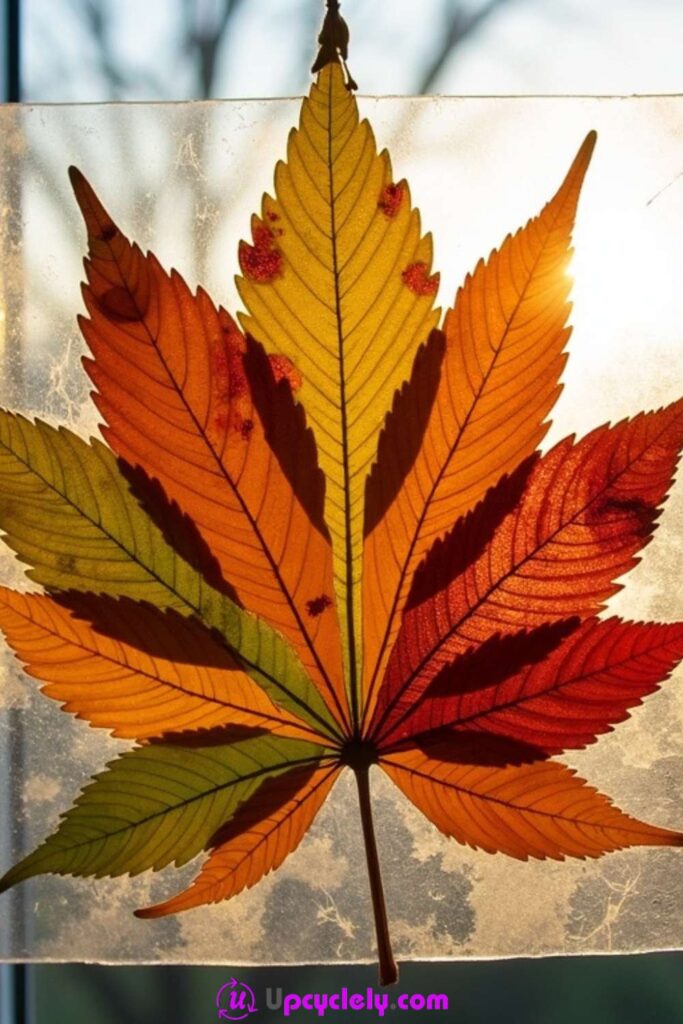
Materials Needed:
- A large, symmetrical leaf (maple leaves work wonderfully)
- Transparent contact paper
- Tissue paper in fall colors (red, orange, yellow, green)
- Scissors
- Craft glue
- String or suction cup for hanging
Steps:
- Pick the Perfect Leaf
Look for a leaf that has a beautiful shape and defined lobes. It should be strong enough to hold its own as the centerpiece of your sun catcher. This is always my favorite part—I search for that one perfect leaf that seems to shine on its own. - Prepare the Background
Cut a piece of contact paper slightly larger than the leaf. Peel back the protective layer and place it sticky side up. This is where I get to play with textures and colors by arranging small tissue paper shapes around the edges of where I’ll place the leaf. - Add the Leaf
Position your leaf in the center of the contact paper and press it down gently. Keep the veins facing upward for a natural texture when light streams through. Watching the sunlight bring the leaf’s intricate patterns to life is pure magic. - Seal and Hang
Cover the entire design with another layer of contact paper to sandwich the leaf and tissue paper in place. Trim the edges neatly, then add a small hole or hook at the top for hanging. Seeing the sun catcher glow in a sunny window always brings me so much joy.
Pro Tip:
Add small squares of metallic gold tissue paper for a touch of shimmer that elevates the sun catcher’s beauty when the light hits it.


